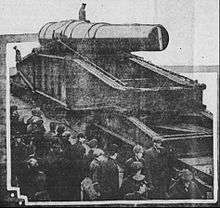16-inch gun M1895
The 16-inch coastal defense gun M1895 was a large artillery piece installed to defend major American seaports. Only one was built and it was installed in Fort Grant on the Pacific side of the Panama Canal Zone.[4] It was operated by the United States Army Coast Artillery Corps.
| 16-inch coastal defense gun M1895 | |
|---|---|
 Crowds in New York watch the shipment of the 16-inch coastal defense gun M1895, January 1915 | |
| Type | Coastal artillery |
| Place of origin | United States |
| Service history | |
| In service | 1915–1943 |
| Used by | United States Army |
| Wars | World War I |
| Production history | |
| Designer | Watervliet Arsenal |
| Designed | 1895 |
| Manufacturer | Watervliet Arsenal |
| No. built | 1 |
| Specifications | |
| Mass | 284,000 pounds (129,000 kg) [1] |
| Length | 35 calibers (56 feet (17 m)) |
| Shell | 2,400 pounds (1,100 kg) shell, 650 pounds (290 kg) nitrocellulose powder[2] |
| Caliber | 16 in (406 mm) |
| Carriage | M1912 disappearing |
| Elevation | -5° to +20°[3] |
| Traverse | circa 160° |
| Muzzle velocity | 2,250 feet per second (690 m/s)[2] |
| Maximum firing range | 19,300 yards (17,600 m)[2] |
| Feed system | hand |
History
Under President Grover Cleveland's administration in 1885, the Board of Fortifications under William C. Endicott was ordered to investigate the value and state of the United States' coastal defenses. Endicott found that America had fallen behind and that new naval technology made many forts and coastal defense weaponry obsolete. The 1886 report recommended a $127-million ($3,614,000,000 in 2020) construction program of breech-loading cannons, mortars, floating batteries, and submarine mines for some 29 locations on the US coastline. New fortifications built in the following decades as a result of this report were called "Endicott Period" fortifications.[5]
Finding a need for long range weaponry, the United States Army Coast Artillery Corps ordered a 16-inch (406 mm) gun, the construction of which began in 1895 at the Watervliet Arsenal in Watervliet, New York.[4][6] The massive artillery piece was designated the M1895 and was completed in 1902; only one was built. At 284,000 pounds (129,000 kg) it weighed more than any gun that had ever been created up to that point.[1] The 32-wheel train car alone weighed 192,420 pounds (87,280 kg). The 56-foot (17 m) long gun could launch a 2,400-pound (1,100 kg) shell 21 miles (34 km).[7]
The weapon was shipped from the Watervliet Arsenal to Watertown Arsenal in Watertown, Massachusetts to be packed for shipment to the Panama Canal Zone. It was installed on an M1912 disappearing carriage in Fort Grant on the Pacific side of the canal in 1915, where it protected the fort until it was scrapped in 1943.[1][3][4] The muzzle section was later preserved and displayed at the Watervliet Arsenal museum, which closed in 2013.[8]
Gallery
_(1904)_(14784412442).jpg) Full-scale model of 16-inch gun M1895 with various ammunition alongside, St. Louis World's Fair, 1904
Full-scale model of 16-inch gun M1895 with various ammunition alongside, St. Louis World's Fair, 1904 Soldiers standing on the 16-inch gun M1895 at Sandy Hook Proving Ground, New Jersey
Soldiers standing on the 16-inch gun M1895 at Sandy Hook Proving Ground, New Jersey
See also
Bibliography
Notes
- Harrisburg Telegraph 1915, p. Front Cover
- Ordnance, pp. 46–47
- Berhow 2015, pp. 168–169, 223
- The History of Fort Tilden 2007
- history.army.mil 2001
- Anonymous 2015
- The Manning Times 1915, p. Front Page
- Crowe 2014
References
- Anonymous (2015). "The new 16 inch (40.5 cm) Coastal cannon of the United States of America". Polytechnischen Journals. Retrieved January 29, 2015.CS1 maint: ref=harv (link)
- Berhow, Mark A., Ed. (2015). American Seacoast Defenses, A Reference Guide, Third Edition. Mclean, VA: CDSG Press. ISBN 978-0-9748167-3-9.CS1 maint: ref=harv (link)
- Crowe, Kenneth C. (August 8, 2014). "Plans dropped for revamped Watervliet Arsenal Museum". Times Union. Retrieved January 29, 2015.CS1 maint: ref=harv (link)
- Ordnance Corps, US Army (1917). Description of 8, 10, 12, 14, and 16-inch Seacoast Guns. Washington: Government Printing Office. ISBN 9780974816708.
- Harrisburg Telegraph (January 29, 1915). "Largest Single Piece of Ordance ever made Being Shipped By Uncle Sam To Protect Panama Canal". Harrisburg Telegraph. Harrisburg, Pa. OCLC 12396379. Retrieved January 29, 2015.CS1 maint: ref=harv (link)
- history.army.mil (March 2, 2001). "William Crowninshield Endicott". history.army.mil. Retrieved January 30, 2015.CS1 maint: ref=harv (link)
- The History of Fort Tilden (2007). "12) 16-inch Gun Technical Data". Archived from the original on May 6, 2009. Retrieved January 29, 2015.CS1 maint: ref=harv (link)
- The Manning Times (February 10, 1915). "Biggest Gun Ready". The Manning Times. ISSN 2330-8826. OCLC 13611767. Retrieved January 30, 2015.CS1 maint: ref=harv (link)
- Description of Seacoast Guns 8, 10, 12, 14, 16-inch
External links
| Wikimedia Commons has media related to 16 inch Coast Gun M1895. |